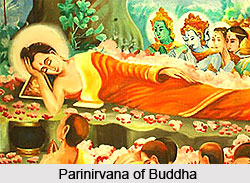 In Mahaparinirvana Sutta it has been stated that at the age of eighty, Gautama Buddha announced that he would soon enter Parinirvana or abandoning the earthly body to enter into a final deathless state. A blacksmith named as Cunda offered him a meal of mushroom delicacy (or soft pork in other opinion), which he took as his last meal. After this Buddha fall terribly ill and instructed his attendant to convince Cunda that the food offered by him had no connection with his passing away and also said that the meal would be considered of greatest merit as it was provided as the last meal to Buddha.
The Mahayana Vimalakriti Sutra mentions that Buddha did not become old or ill in reality but he purposefully presented such an appearance to teach the universe that life is not permanent and death is obvious so that they strive for Nirvana.
In Mahaparinirvana Sutta it has been stated that at the age of eighty, Gautama Buddha announced that he would soon enter Parinirvana or abandoning the earthly body to enter into a final deathless state. A blacksmith named as Cunda offered him a meal of mushroom delicacy (or soft pork in other opinion), which he took as his last meal. After this Buddha fall terribly ill and instructed his attendant to convince Cunda that the food offered by him had no connection with his passing away and also said that the meal would be considered of greatest merit as it was provided as the last meal to Buddha.
The Mahayana Vimalakriti Sutra mentions that Buddha did not become old or ill in reality but he purposefully presented such an appearance to teach the universe that life is not permanent and death is obvious so that they strive for Nirvana.
Ananda protested against Buddha`s decision to enter Parinirvana in the remote jungle of Kushinara. Buddha reminded Ananada about the glorious past of Kushinara , which was ruled by the Mallas.
Buddha then asked all his attendant Bhikshus to clarify the doubts and questions they had. They had no questions. Buddha then finally entered Parinirvana. His final words were "All composite things pass away. Strive for your own liberation with diligence." His body was cremated and the relics were placed in monuments or stupas. Some of this monuments of Stupas which contain the body part of Buddha are still believed to be present.
Passing of Buddha was in 486 BCE according to Theraveda record or 383 BCE according to Mahayana record. Buddha told his disciples not to follow any leader after his death. However, at the first Buddhist Council, the Sangha selected Mahakasyapa as their leader.




















